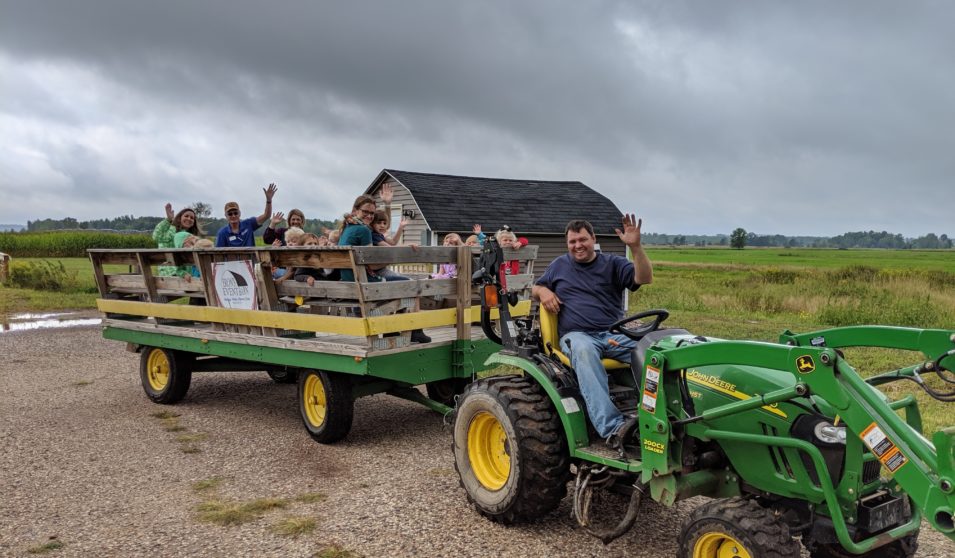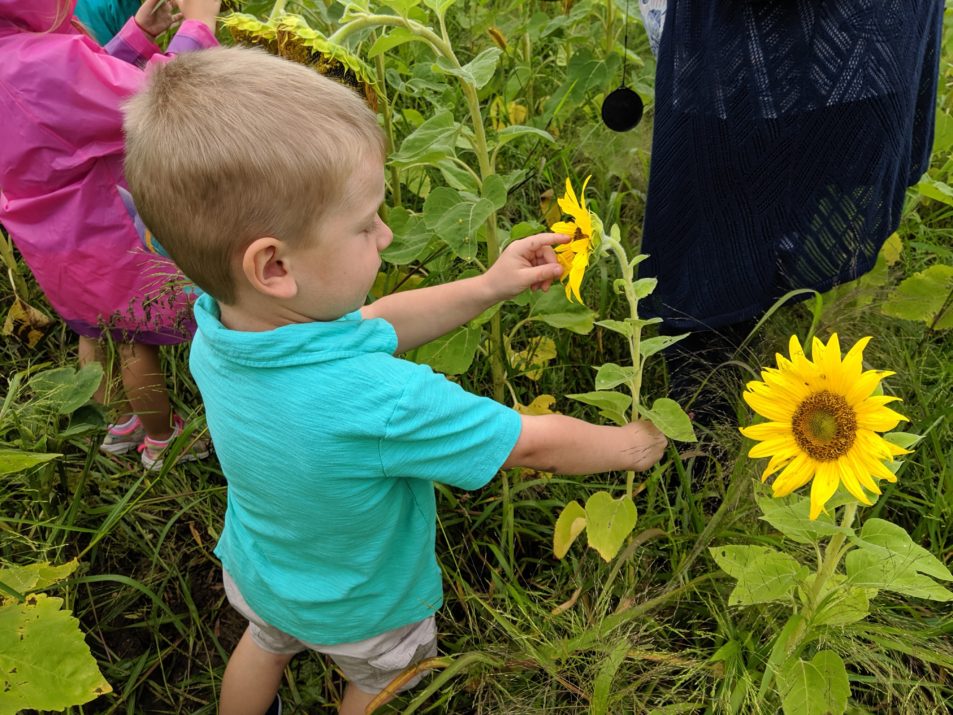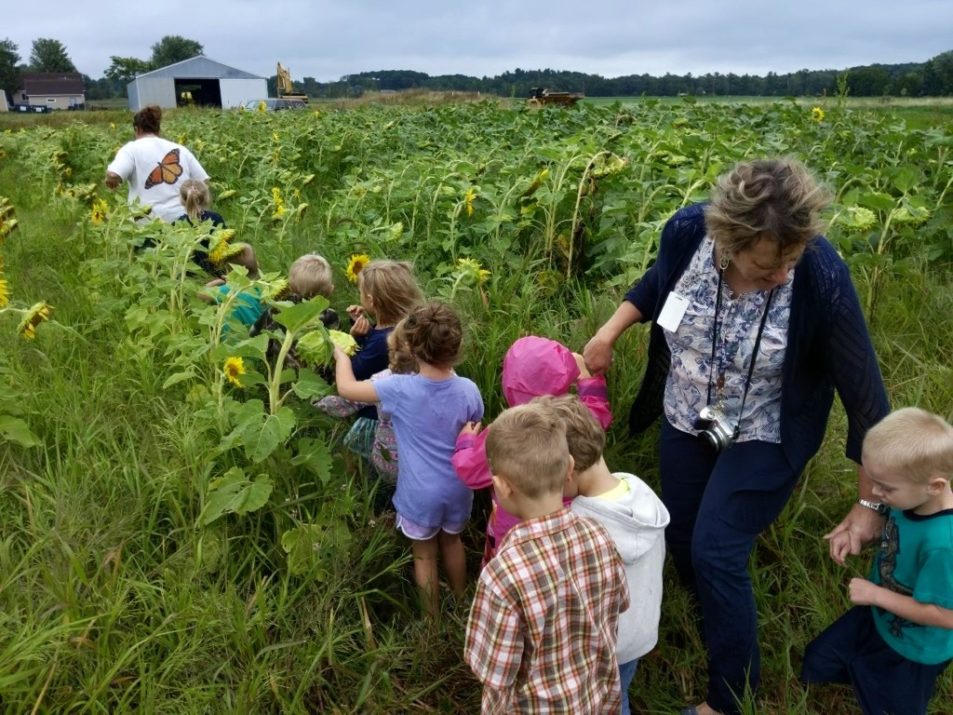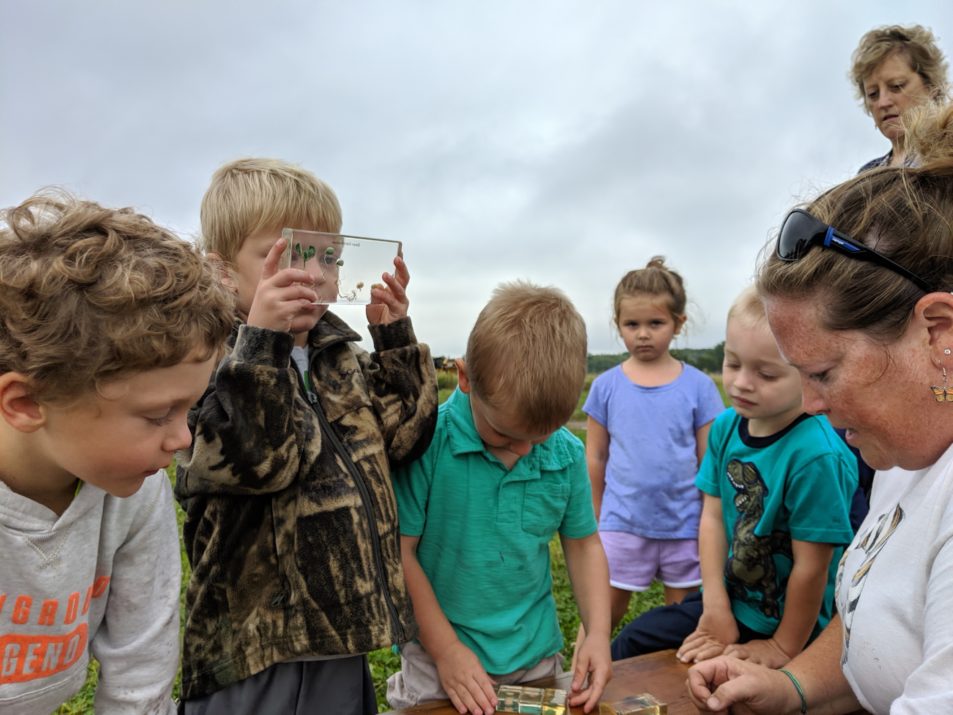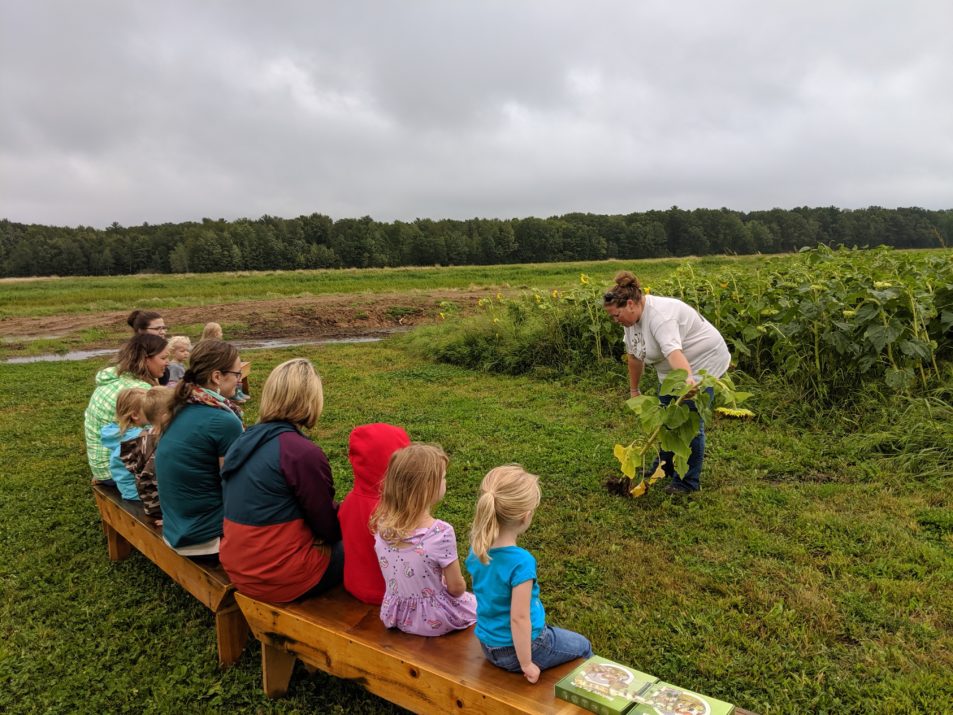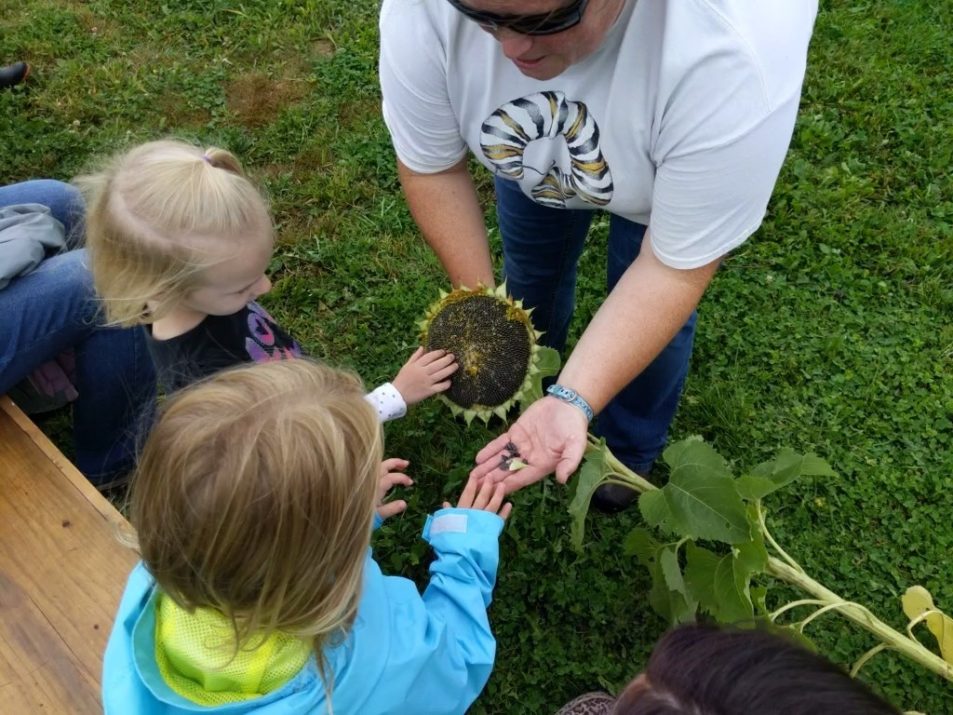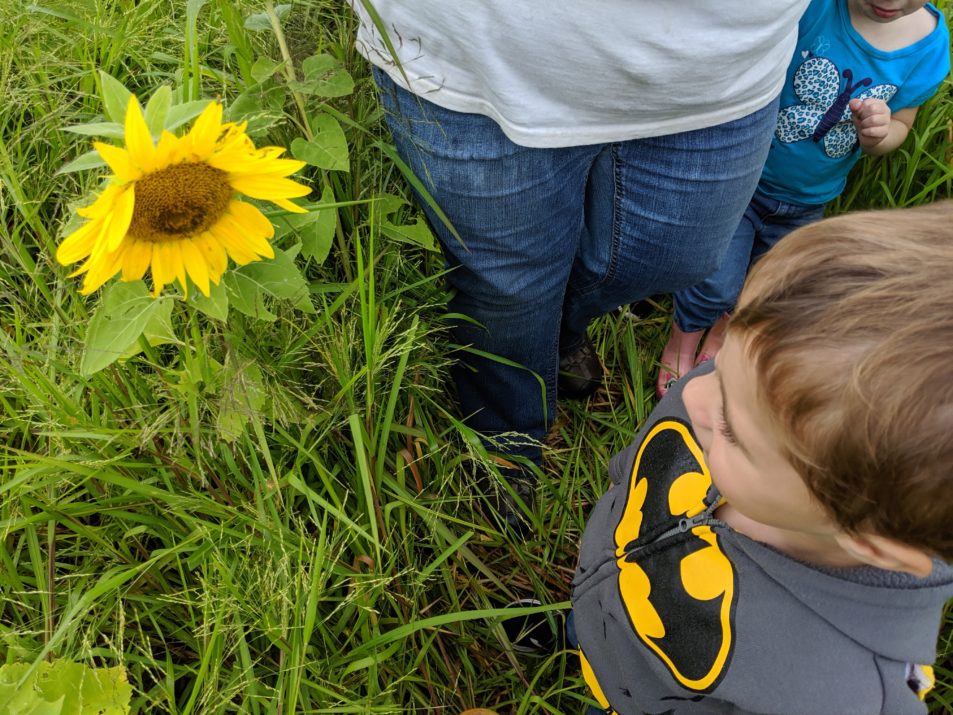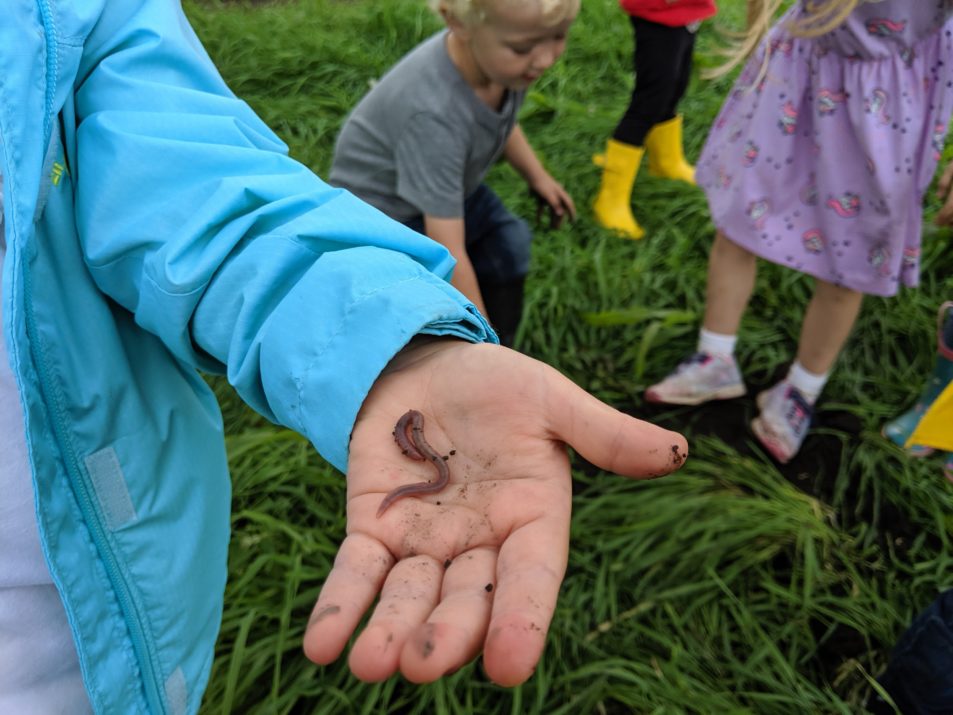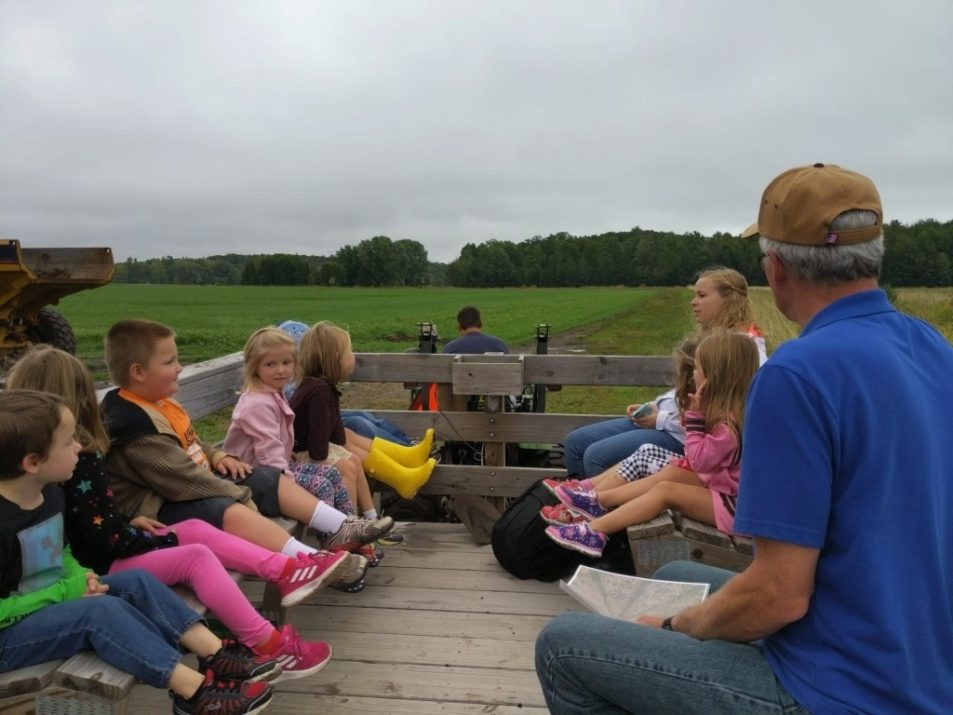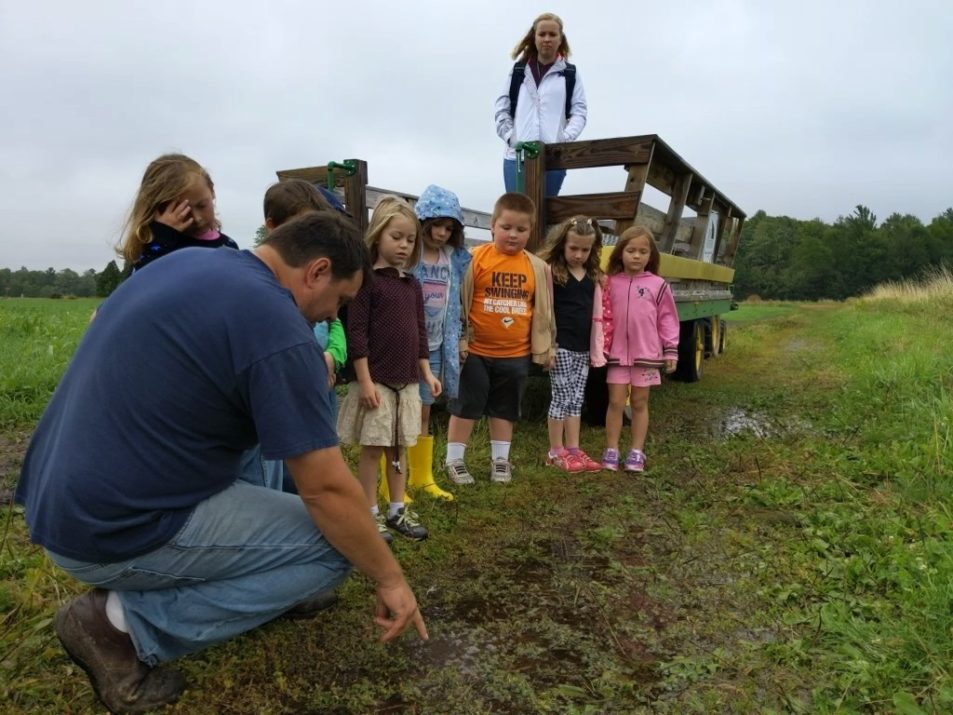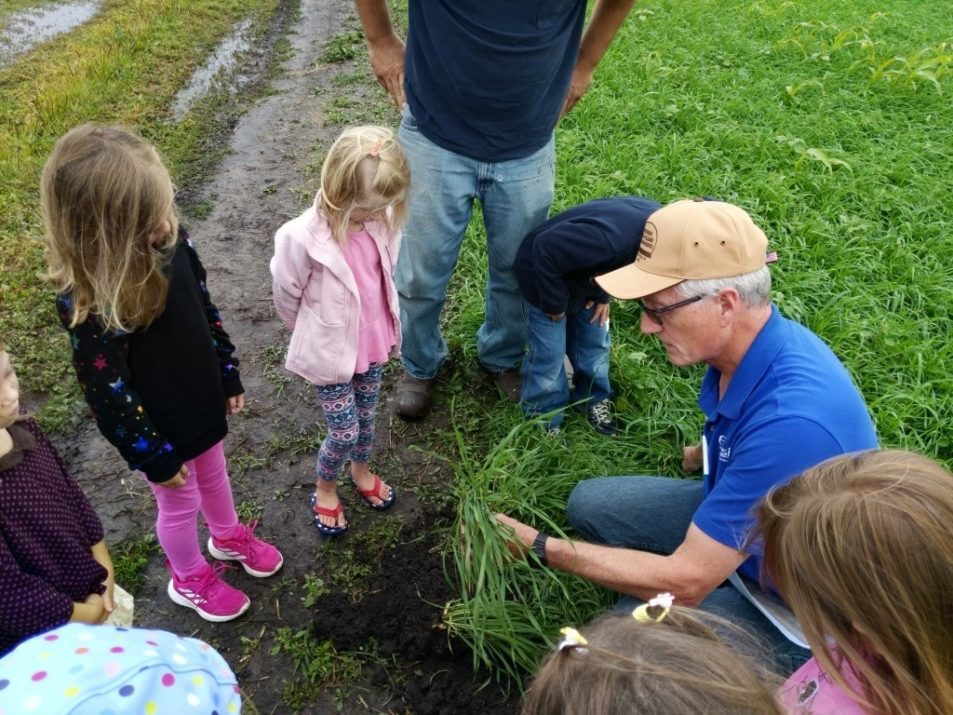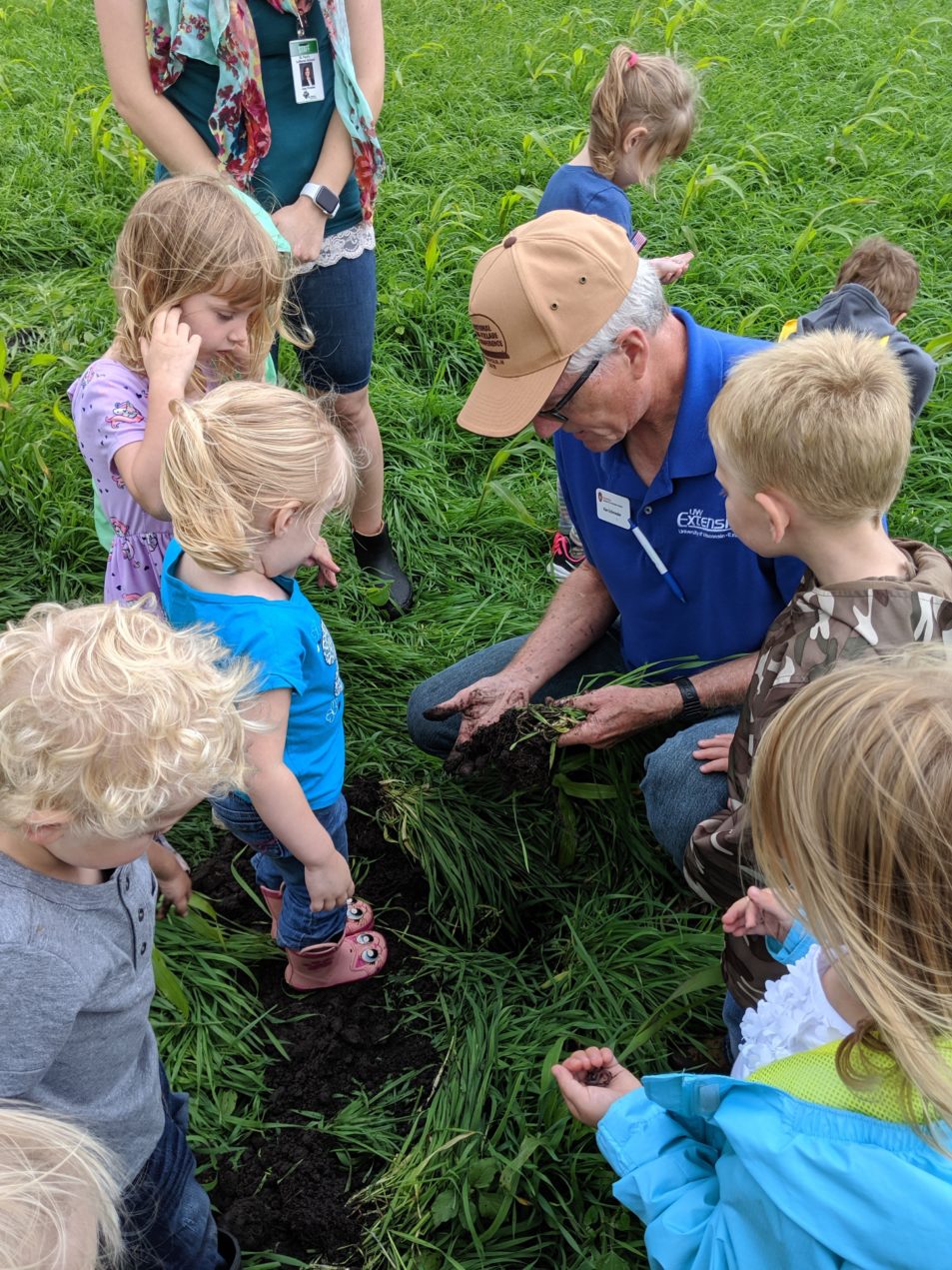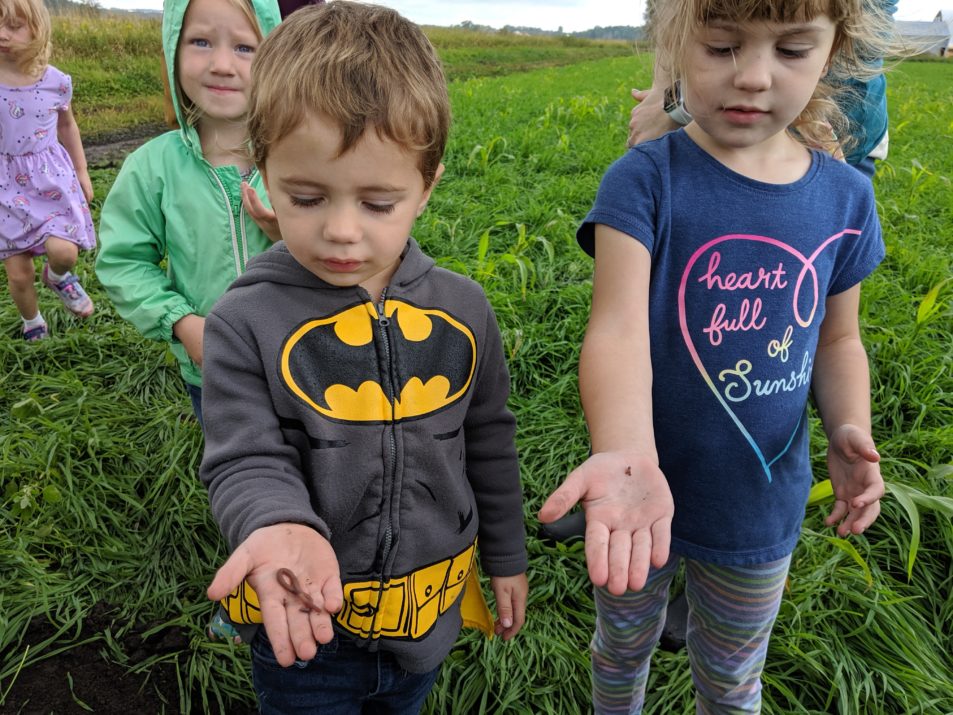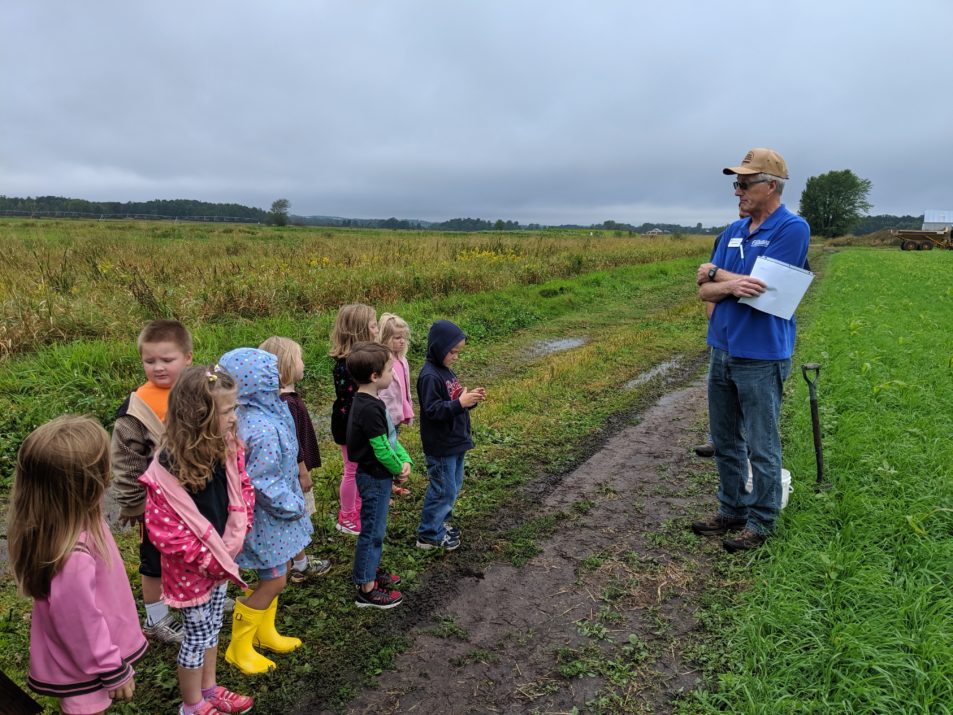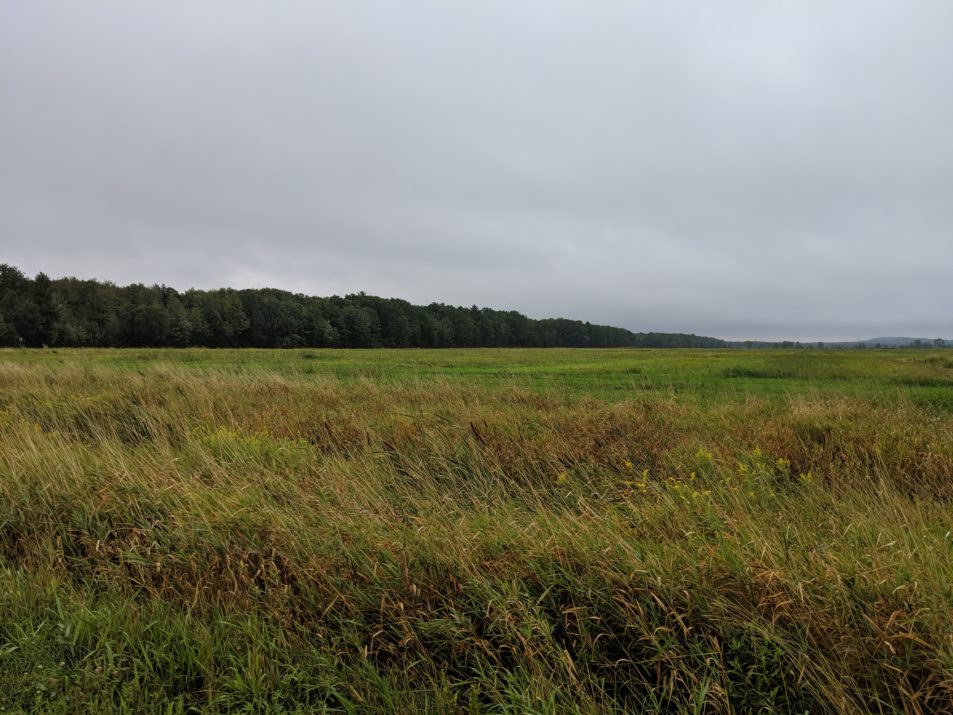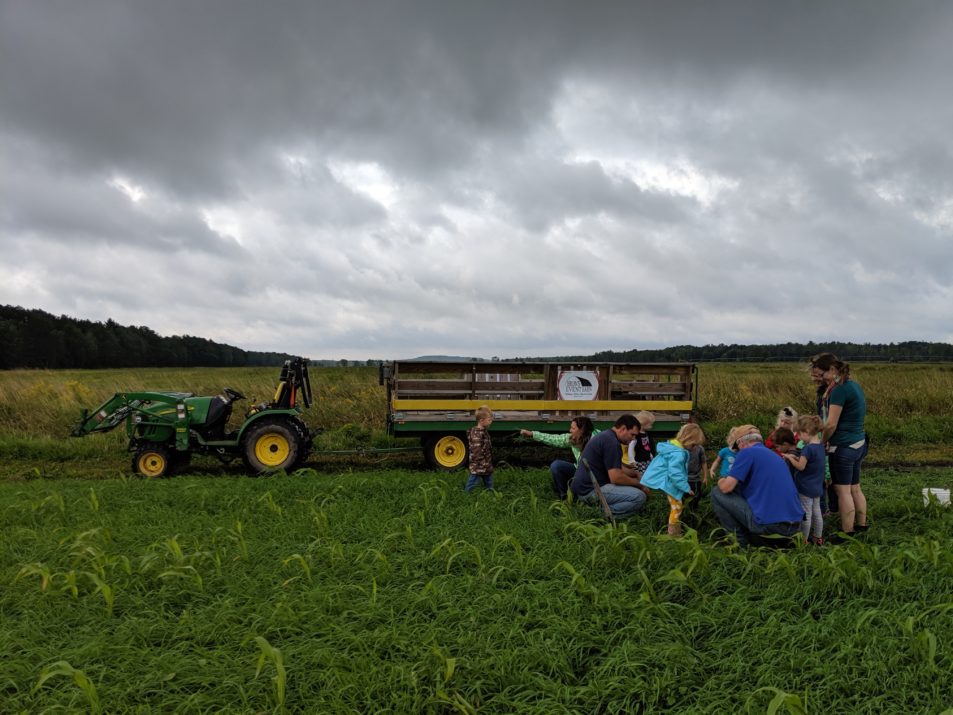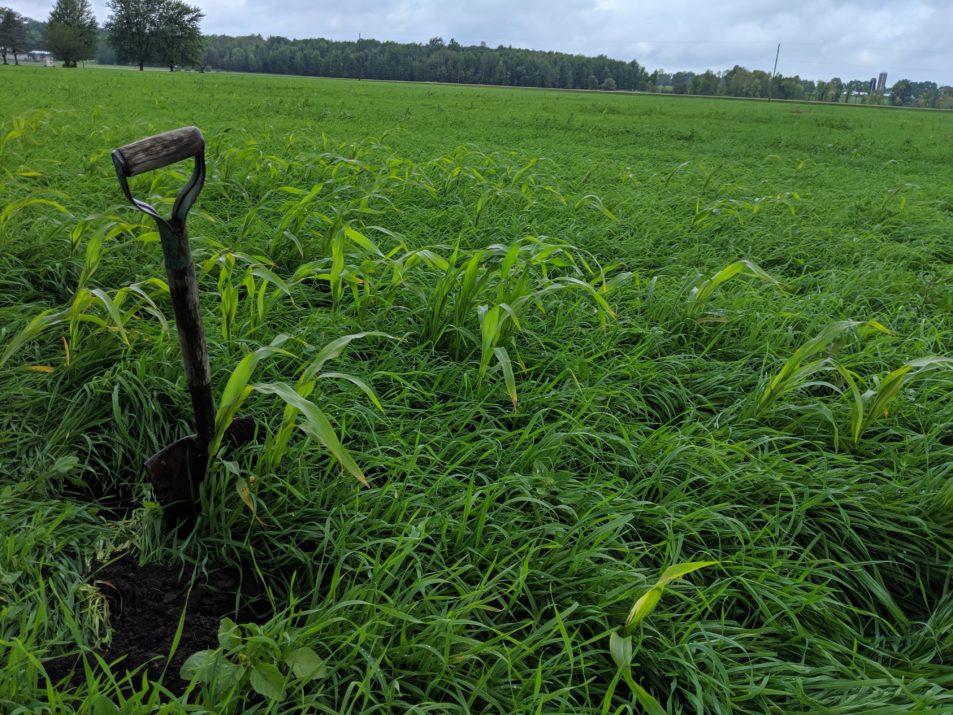On a wet morning this past fall, 40 pairs of tiny feet filed off a school bus onto the green fields of John Eron’s family farm in Portage County. The class of preschool students from St. Paul’s Little Lambs Pre-K were split up into three groups that traveled around the farm, learning about organisms in the soil, the importance of soil health, the relationship between land use and water quality, pollinators, and how seeds germinate.
“Now, who can tell me what color this sunflower’s petals are?” asked Tracy Arnold, Portage County Conservation Technician.
“Yellow!” shouted a few of the enthusiastic five-year-olds.
“Correct!” replied Arnold. “And what kind of insects like to land on flowers?”
“Bees!” answered the group.
“That’s right! Bees like to land on the flowers because they like the petal’s yellow color,” explained Arnold. “And as the bees fly around from flower to flower, they share each flowers’ pollen. This is pollination and it helps the flower make more seeds that will drop and in turn, grow more flowers.”
The field day is part of a larger community education effort
by the Farmers of Mill Creek, a producer-led group based around the Mill Creek
watershed in Portage and Wood Counties. Founded in 2016, the group is comprised
of a mix of farming operations that work to promote conservation practices and
provide public education. The group’s projects are supported through the
Wisconsin Department of Agriculture, Trade, and Consumer Protection’s (DATCP)
producer-led watershed protection grant program.
Meanwhile in the nearby field, farmer John Eron and UW-Extension Agricultural Agent Ken Schroeder dug up cross sections of topsoil to show the group of six year olds all the worm channels and organisms underneath their feet.
“As you can see, worms make these holes as they crawl through the soil,” said Eron, pointing to the porous black soil at the end of the shovel. “Worms help make the soil really healthy and that helps the soil soak up rain.”
The students erupted into questions and anecdotes about worms and soil. The teachers smiled as Eron and Schroeder worked to satisfy their curiosity.
John Eron, one of the founding members of the Farmers of Mill Creek, has worked closely with the Portage County Conservation Department and UW-Extension over the past three years to enrich local classroom curriculum with hands-on presentations, farm tours, and pollinator habitats.
The producer-led group’s classroom outreach also began in 2016 with three schools and roughly 70 students. The partnership gave presentations on the value of pollinator habitats and native species, discussing the region’s historical ecology and role natural prairie habitats play in larger ecosystems.
The popularity of the producer-led group’s program quickly spread throughout the area. This past year, the team visited 14 different schools and spoke with 540 students.
“Not only were we able to reach all those students, but each one of those kids received a native prairie plant or seed to plant in their school,” added Arnold. “Since 2016, many of these schools have started school gardens. Even if they’re small ones, those gardens still have an impact on pollinators and those kids can see it every day when they go to school and in the years after.”
Their goal is to help students make connections between what they learn inside the classroom with real world applications and encourage the students to explore natural biology. The Farmers of Mill Creek understand that providing this applied context to classroom curriculum is invaluable for kids to understand why these lessons are important.
“Everything we do, we try to take a holistic approach,” said Eron. “There is a pretty wide spectrum of information in classroom curriculum. Through our education programming, we provide students with real world applications of this information and the context to why this is important. When we [first started the in-classroom presentations], we decided to not provide any ‘fluff.’ We want to be honest and upfront about real challenges, as well as the real benefits of farm conservation.”
Complimenting K-12 curriculum with such honesty also encourages kids to explore without feeling afraid to fail. This past year, the Farmers of Mill Creek lent a 10 foot no-tillage drill to a local high school for a school project. The class was going to use the drill on a small test plot of cover crops and report the soil differences to the Farmers of Mill Creek. Instead, the students faced a frustrating reality that is so common in farming – bad weather.
“It rained,” recalled Eron. “It continued to rain for such an extended period of time that they never had the opportunity to get their cover crops planted. Yet there were farmers in the area who knew the little quirks of their land and the weather, and knew how to manage all of it well enough to be able to plant cover crops during the same timeframe.
“The students were worried and slightly embarrassed to report back to our group because they were not able to do what they intended to do,” continued Eron. “But we talked with them and made them more comfortable with the letdown by helping them realize that this is the reality of farming. This stuff does not always work out. Sometimes, it just keeps raining. But the neat part is how much they learned by just trying.”
For the Farmers of Mill Creek, letdowns wind up becoming some of the best teachable moments. The producer-led group invited the high school students to come out to a field day to learn about best management practices and the small nuances of conservation practices like no-tillage and cover crops that come with years of experience.
“We talked with them about what they saw as a failure, which to us was a learning opportunity,” said Eron. “We can show how to calibrate that drill and the stuff you need to know to be able to get that edge on your management that makes all the difference.”
The Farmers of Mill Creek use these education principles when working within the farming community in the Mill Creek watershed as well. In a watershed with varying and challenging soils, the use of conservation practices is not widespread. Moreover, the past three years of rain and economic strain have limited opportunities for experimentation. These conditions have made the producer-led program an incredibly effective resource for the area.
“I am pretty confident to say that if it wasn’t for the cost-share dollars provided through DATCP’s producer-led program, we wouldn’t see a lot of cover crops planted during these challenging times,” said Schroeder. “But it’s a work in progress. We keep hoping that the economy is going to turn around and the weather is going to give us a better year.”
As seasonal weather becomes more variable, the economic value of conservation practices greatly increases. Reduced or no-tillage and cover crops are two kinds of practices that help fields absorb large amounts of rainwater and prevent topsoil from washing away. Additionally, other conservation practices like buffer strips and pollinator habitats further improve nutrient retention and ecosystem activity.
The Farmers of Mill Creek and the local conservation partners understand that conservation practices work differently for each operation. They seek to be a resource and support organization to encourage farmers to try new things in the watershed.
“It’s a gradual thing and a slow ship to turn,” said Schroeder. “Farmers often rely on tradition and experience, as they learned how to farm from their grandparents and parents and they know what works for them. I help write grants, organize field days, and do one-on-one consulting with farmers who are interested in conservation practices. It’s important that they not only have a direct point of contact to be able to work with, but also develop a comfort level with these new practices.”
The value of the program also lies within the inherent collaboration and shared knowledge between the participating farmers. John Eron acknowledges that farmers are often slow to fully incorporate new practices, but that does not necessarily come from an aversion to change. In fact, the opposite is more likely true.
“Farmers by nature are innovators. True farmers have to adapt to the environmental changes around them; I mean, that’s farming,” said Eron. “Part of adapting to our environment we live in is trying out different kinds of practices and many of those are conservation measures. We are now uniquely at a point where some of these conservation measures are becoming more important to just be able to stay in farming.”
For more information about the Farmers of Mill Creek, visit: www.portage.extension.wisc.edu/agriculture/farmers-of-mill-creek-watershed-council
For more information about DATCP’s Producer-Led Watershed Protection Grants program, visit:
https://datcp.wi.gov/Pages/Programs_Services/ProducerLedProjects.aspx
For more information and helpful local resource available through Portage County Land and Water Conservation Department, visit:
https://www.co.portage.wi.us/department/planning-zoning/land-and-water-conservation

